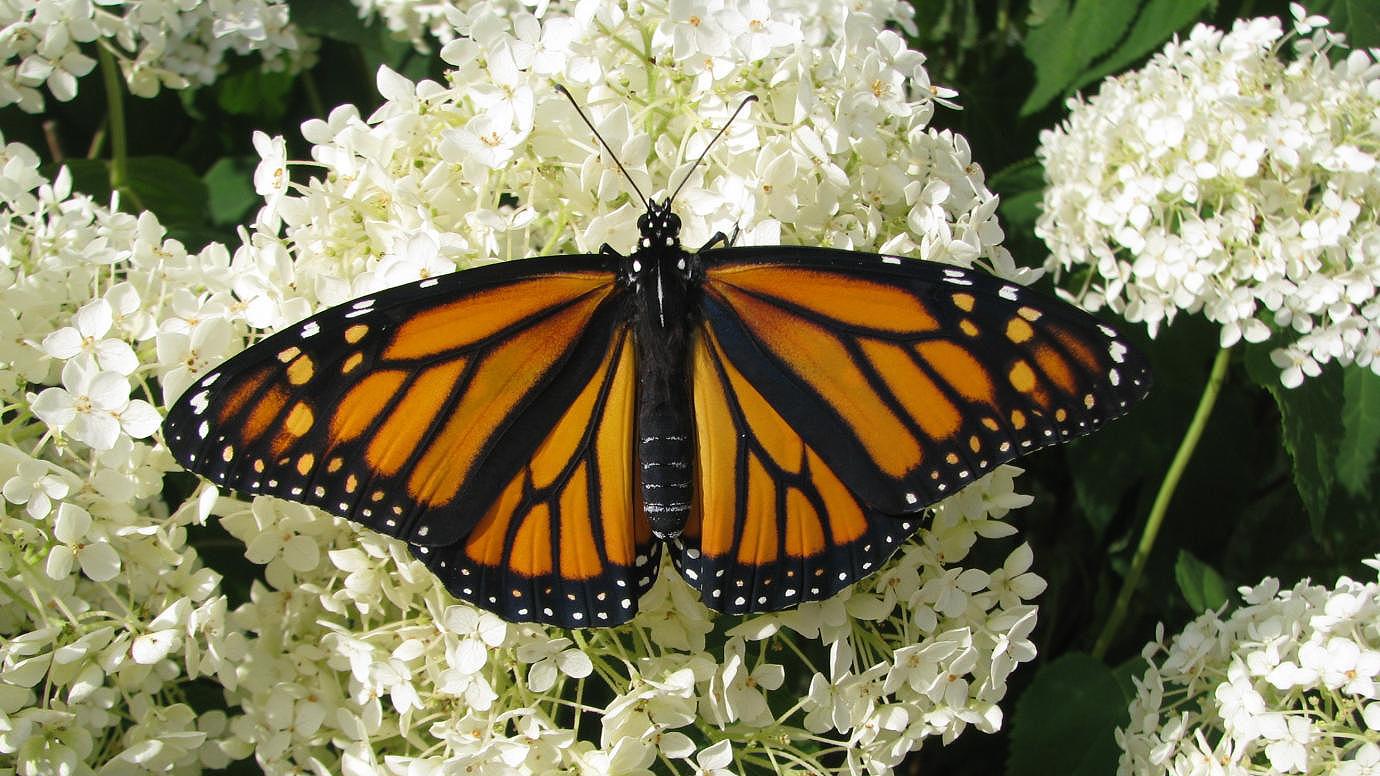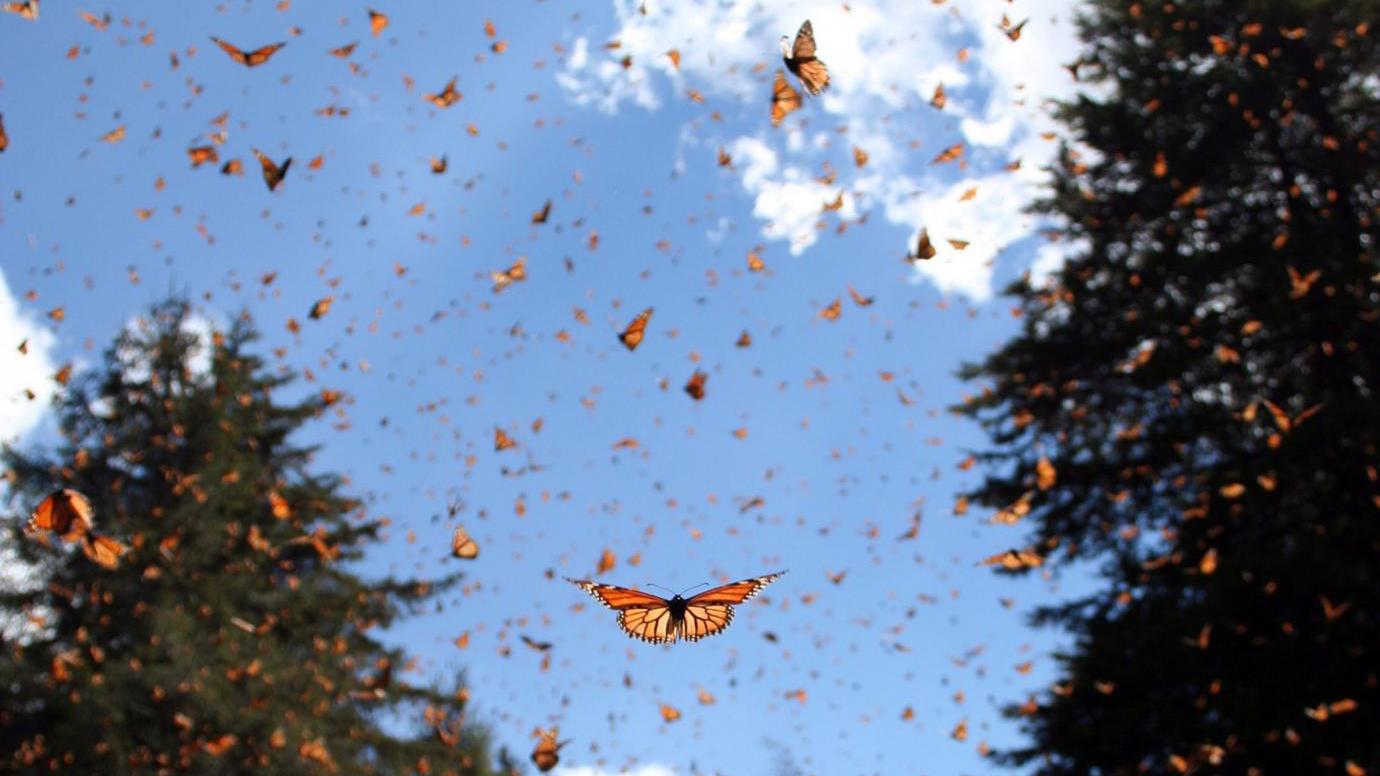The team discovered that migratory monarchs consumed less oxygen and had significantly lowered flight metabolic rates, which likely increases their ability to fly long distances compared to non-migratory butterflies.
A North American original
To better understand monarch genetics and the basis for migratory behavior, Kronforst’s team sequenced and compared the genomes of 101 butterflies, including migratory North American monarchs, non-migratory monarchs from around the world and a few closely related species.
The researchers analyzed the monarch’s evolutionary origins using genetic comparisons. They traced the ancestral lineage of monarchs to a migratory population that likely originated in the southern U.S. or Mexico. The monarch’s current worldwide distribution appears to stem from three separate dispersal events—to Central and South America; across the Atlantic and across the Pacific. In all three cases, the butterfly independently lost its migratory behavior.
The monarch’s North American origin runs counter to a long-standing hypothesis that the butterfly originated from a non-migratory tropical species, which later developed the ability to migrate. While historical records have suggested that the monarch’s dispersal across the Pacific and Atlantic occurred in the 1800s, the analysis indicated the monarch actually crossed the oceans thousands of years ago. The authors note that more work needs to be done to fully document the butterfly’s evolutionary history.
“In order to clearly resolve the history of monarch butterflies, we still need additional fossil, archaeological and genetic data, as well as more advanced technology, becoming available in the future,” said study author Shuai Zhan, a professor in Shanghai Institutes for Biological Sciences and a former joint postdoctoral fellow at the University of Chicago and the University of Massachusetts Medical School.
Slow and Steady
To study the genetic basis for migration, the team compared the genomes of migratory butterflies against the three non-migratory populations. They identified more than 500 genes—most of which are involved in muscle, developmental and neural function—that differed to some degree. But a single gene disparity stood out.
Migratory butterflies expressed greatly reduced levels of collagen IV α-1, a gene involved in flight muscle formation and function. The team discovered that migratory monarchs consumed less oxygen and had significantly lowered flight metabolic rates, which likely increases their ability to fly long distances compared to non-migratory butterflies.
“Migration is regarded as a complex behavior, but every time that the butterflies have lost migration, they change in exactly the same way, in this one gene involved in flight muscle efficiency,” said Kronforst. “In populations that have lost migration, efficiency goes down, suggesting there is a benefit to flying fast and hard when they don’t need to migrate.”
The Color Gene
The researchers also investigated the genetic basis for the monarch’s famous coloration. A small percentage of monarchs, most notably in Hawaii, possess white and black wings instead of orange. Comparing the genomes of these butterflies against normally colored populations, the team discovered a single gene appears to function as a pigmentation switch.
This gene, which codes for a protein of the myosin motor protein family, has never before been implicated in insect coloration. Its mutation likely disrupts the pigment transport to the wings, making the monarchs white. A related gene in mice, myosin 5a, has been shown to affect coat color in a similar way. The gene represents a new genetic pathway to explore insect coloration, according to Kronforst.
Migration in Peril
Although the monarch isn’t in danger of extinction, its famous mass migration across North America appears to be in peril. In 1996, around one billion monarchs migrated to Mexico for the winter. Estimates for the past year place the number at around 35 million. A likely culprit is the loss of milkweed, the monarch’s primary habitat, due to agricultural herbicide use. Meanwhile, monarchs that used to migrate are transitioning into non-migratory populations around the Gulf Coast.
The results of this study emphasize the need for conservation efforts to preserve the iconic migration and extend the extraordinary evolutionary history of the monarch butterfly, according to the authors.
“You used to see huge numbers of monarchs, clouds of them passing by,” said Kronforst. “Now it looks quite possible that in the not too distant future, this annual migration won’t happen.”
The study, “The genetics of monarch butterfly migration and warning colouration,” was supported by the National Institutes of Health, the National Science Foundation and Neubauer Funds from the University of Chicago.
Additional authors include Wei Zhang from the University of Chicago, Kristjan Niitepold and Jeremy Hsu from Stanford University, Juan Fernandez Haeger from the University of Cordoba, Myron P. Zalucki from the University of Queensland, Sonia Altizer from the University of Georgia, Jacobus C. de Roode from Emory University and Steven M. Reppert from the University of Massachusetts Medical School.








